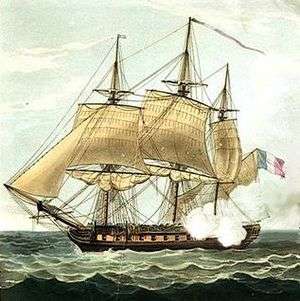French frigate Weser (1812)
Weser, or Wezer[3] was a Pallas-class 44-gun frigate of the French Navy, designed by Sané. She was launched in 1812. In 1813 server British ships captured her. The Royal Navy recommissioned Weser her as HMS Weser.
 Clorinde, sister-ship of French frigate Weser (1812) | |
| History | |
|---|---|
| Name: | Weser |
| Namesake: | Weser |
| Builder: | Jean-François Guillemard, Amsterdam[1] |
| Laid down: | April 1811 [1] |
| Launched: | 12 May 1812 [1] |
| Commissioned: | August 1812 [1] |
| Name: | HMS Weser |
| Acquired: | 1815 by capture |
| Fate: | Sold 1821 for breaking up |
| General characteristics | |
| Class and type: | Pallas-class frigate |
| Displacement: | 1,080 tonnes |
| Length: | 46.93 m (154 ft 0 in) |
| Beam: | 11.91 m (39 ft 1 in) |
| Draught: | 5.9 m (19 ft 4 in) |
| Propulsion: | 1,950 m2 (21,000 sq ft) of sail |
| Complement: | 326 |
| Armament: |
|
| General characteristics In British service[2] | |
| Tons burthen: | 1,08710⁄94 (bm) |
| Length: |
|
| Beam: | 40 ft 1 1⁄4 in (12.2 m) |
| Depth of hold: | 12 ft 6 1⁄4 in (3.8 m) |
| Propulsion: | Sail |
| Complement: | 300 |
| Armament: |
|
Career
On 30 September 1813, the French frigate Weser, under the command of capitaine de vaisseau Cantzlaat, Chevalier de l'Ordre Impérial de la Réunion, sailed from the Texel for the North Sea. There she captured two Swedish ships before a gale on 16 October took away her main and mizzen mast. Two days later HMS Scylla, Commander Colin Macdonald, captain, encountered her 60 leagues (290 km) west of Ushant, making her way towards Brest under jury main and mizzen masts. Rather than engage her and risk being crippled and so unable to follow her given the weather, Macdonald decided to follow her.[4]
On 20 October 1813, Royalist came up with HMS Scylla, which was following Weser. The two British captains decided to attack Weser. They engaged her for about an hour and a half before they had to withdraw to repair their rigging. At about this time a third British vessel, the fourth rate Rippon came up. The next morning, as Rippon and Royalist sailed towards Scylla to renew their attack, Weser sailed towards Rippon and struck, after first firing two broadsides towards Scylla. Scylla suffered only two men wounded in the entire engagement. Royalist suffered more heavily, having two men killed and nine wounded. Weser lost four men killed and 15 wounded.[4] The Royal Navy took her into service as HMS Weser.[4][Note 1]
Citations and references
Notes
Citations
- Demerliac, n°680, p.94
- Winfield, p.
- Roche, p.476
- "No. 16793". The London Gazette. 23 October 1813. pp. 2119–2120.
- "No. 17041". The London Gazette. 18 July 1815. pp. 1462–1463.
References
- Demerliac, Alain (2004). La Marine du Consulat et du Premier Empire: Nomenclature des Navires Français de 1800 A 1815 (in French). Éditions Ancre. ISBN 2-903179-30-1.CS1 maint: ref=harv (link)
- Roche, Jean-Michel (2005). Dictionnaire des bâtiments de la flotte de guerre française de Colbert à nos jours, 1671 - 1870. Group Retozel-Maury Millau. p. 476. ISBN 978-2-9525917-0-6. OCLC 165892922.
- Winfield, Rif (2008). British Warships in the Age of Sail 1793–1817: Design, Construction, Careers and Fates. Seaforth Publishing. ISBN 1-86176-246-1.CS1 maint: ref=harv (link)